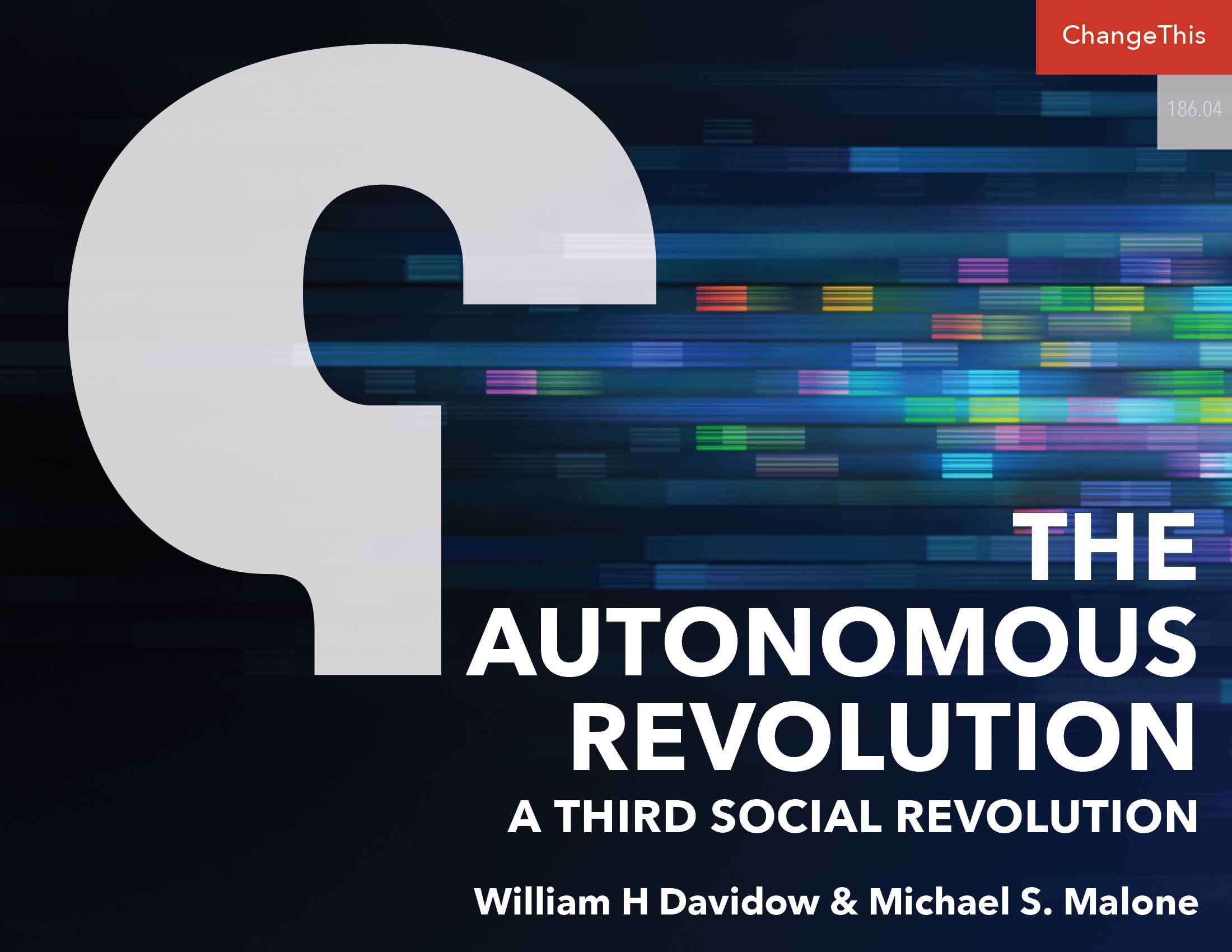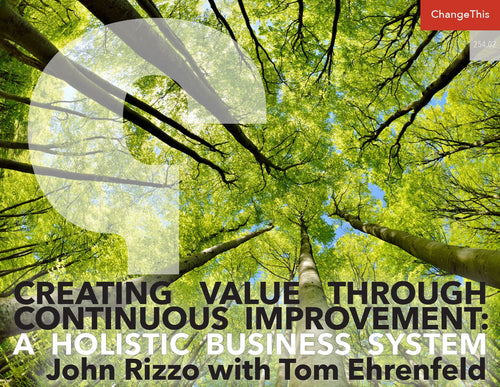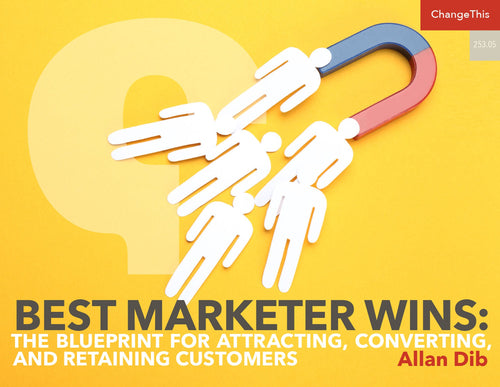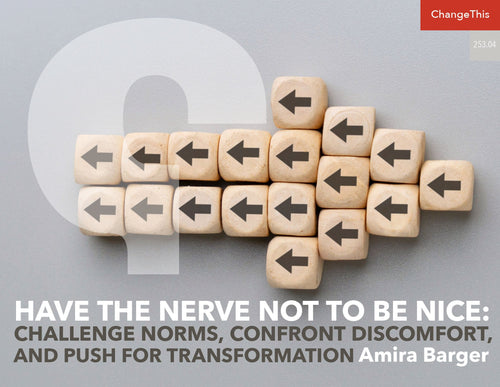The Autonomous Revolution: A Third Social Revolution
For the third time in history, society is undergoing a social phase change. We are well on our way to creating the Autonomous Revolution.
Its two predecessors, the Agricultural and the Industrial Revolutions, have taught us what to expect. Our institutions will assume new forms and operate using different tools and according to new rules; our sense of time, space, and self will be irrevocably altered. Our memories of what came before the new epoch will be skewed, and the few revenants from the past that do survive it will have limited applicability in the future. But at least for a time, our gut instinct will be to continue to apply the old rules, values, and beliefs, in a losing battle with the inevitable.
The societal phase changes of the past enabled us to gain control over the natural world, create civilizations, and live comfortable and meaningful lives. But those achievements came at the cost of great human suffering. Though we forged societies with common goals, beliefs, and values, the tools that we used to do it included wars, revolutions, crusades, jihads, and genocides. Empires rose and fell. New empires are emerging today—in many ways bigger and more powerful than the great empires of the past. But they are arising in a territory we never anticipated—the virtual realm—and in the forms of corporations such as Facebook, Google, and Amazon.
Society is already feeling some of the early effects of the Autonomous Revolution. The ice-hard stability of the good job is being replaced by the indeterminate “gig.” Countless other jobs have been shipped overseas or automated out of existence, devastating the middle class. Mind-altering processes are being used to reengineer our children’s brains. Our Brave New Social Networking world looks less open and connected every day—and more and more like the dystopian surveillance states of George Orwell and Aldous Huxley.
If we want to turn the forces of the Autonomous Revolution to our advantage, we need to see them as they are, and not through the lenses of our old rules, values, and beliefs. Only then can we develop the reasoned approaches that will allow us to mitigate their less desirable side effects and benefit from the great advances they make possible.
If we aggressively and intelligently manage those changes, we will live in a world of abundance. We will build stronger communities and families and have better and more efficient government. Human productivity will increase. Civilization will become more energy-efficient and our environment cleaner. Health care will be tailored to meet our individual needs and life expectancy will increase. The quality of products and services will improve, and they will be individualized to satisfy our personal tastes.
But achieving those benefits will require us to manage the challenges of the impending, massive, change in a rational fashion. At the very least, we will need great leadership to get us through.
CHANGING FORM
Let’s look at the process more closely. The term phase change, like quantum shift, paradigm, and virtual, comes from the world of science and technology, in this case, the world of physics. The phenomenon is something we experience frequently in everyday life.
Anyone who has put water in a freezer has witnessed it. Collections of water molecules that are warmer than 32 degrees F exist in liquid form. Below that critical temperature they become ice and sometimes form beautiful crystals like snowflakes. When water changes to ice, it undergoes a phase change.
When water changes phase, it changes its form. And the rules governing the behavior of ice bear no resemblance to the rules governing water. That’s why physicists and engineers use the rules of fluid dynamics when dealing with water and those of solid mechanics when dealing with ice.
The tools we use to deal with water are pumps and pipes. But pumps won’t pump ice, and ice breaks pipes. In water’s solid phase, we use snow shovels, plows, and icebreakers. What is crucial to appreciate is that our understanding of water gives us no clues about how to deal with ice.
Human social systems go through structural transformations that are similar to phase changes in physical systems. Since we are talking about social systems and not molecules, the analogy is inexact, but when enough structural transformations accumulate in a human society, its institutions change form, obey different rules, and require different tools to manage them.
In the physical world, phase changes are distinct and frequently happen in relatively short periods of time (there are also many examples of extremely long phase changes, such as in geology, when sedimentary rock changes into metamorphic rock). Phase change in human society is a relatively slow process, measured in human lifetimes, and it tends to be cumulative—a set of minor structural transformations combine to create more significant ones, which then add up in their turn. These structural transformations occur in the realms of technology, science, medicine, ideas, politics, economics, religion, and more.
Minor structural transformations are narrowly focused, affecting specific areas of human endeavor, and they happen quickly. You have probably experienced dozens of them in the course of your life. Look at the world around you—and then try to remember the world of your childhood. If you are in your fifties, the differences are remarkable. Think of the media you grew up with and the media you use today. When you were younger you watched broadcast television and listened to vinyl records; you read printed newspapers, magazines, and books, and the movies were something you went to. If you watch television today, you probably receive it over cable or through the Internet; your record collection is on your smartphone; the news is curated for you and sent to you via your social network; and when you need an encyclopedic reference, you search Wikipedia. Movies are streamed to your home by Netflix, Amazon Prime, or any of a host of competing online services.
In the past, written information and recorded music were inscribed on physical objects— printed-and-bound pages, grooved and later digitized discs. Today they reside in invisible bits and bytes. The physical infrastructures that support the media have changed as well. Screens, smartphones, and fiber optic cables have replaced newsstands, delivery trucks, and printing presses. Media business models are different. You no longer have to purchase an entire album of music; you can buy your favorite song. In the past, broadcast television was free and you paid for your local newspaper. Today, you subscribe to online video services but can read hundreds of newspapers, from every corner of the world, on your screens for free.
Major structural transformations occur when minor structural transformations accumulate and interact, impacting broad segments of the economy and society. Since they are a result of agglomeration, they happen relatively slowly.
Right now, any number of minor structural transformations are happening in the financial industry. For example, consumers can use Apple Pay and Google Pay to make payments at retail establishments, substituting their smartphones for their credit cards. Once the payments are entered, they are processed over the old credit card networks. In China, smartphones are being used as a platform for peer-to-peer payment systems. Using applications such as We-Chat, smartphone customers made $5.5 trillion in payments without the need to run the transactions through a credit card network. Facebook’s recent announcement about forming a virtual currency consortium, Libra, is an example of the type of development we should anticipate in the future—a harbinger of a world where credit and debit cards may become obsolete and currencies are ruled by commercial enterprises.
The first experiments with online banking date all the way back to 1981. In 1996, NetBank, the first truly successful Internet bank, was founded. In the early 2000s, automated portfolio management software began to be widely used by financial advisers. Today, robo-advisers that manage investment portfolios for consumers are available from companies such as Betterment and Wealthfront for a fraction of the cost of human advisers. Scores of other financial applications (Fintech) are available, and countless more are in the development pipeline.
When peer-to-peer payment systems are integrated with peer-to-peer lending systems, Internet-only banks, and robo-advisers, the future of credit cards, retail banks, and financial advisers as we know them will be challenged. When much of the financial services industry has been absorbed into virtual space and is operated by automatons, a major structural transformation will have occurred.
A similar story could be written about the media industry. Minor structural transformations affecting print, recording, broadcasting, and publishing are combining to create a major structural transformation in the media space.
Social phase changes occur when major structural transformations combine and interact over extended periods of time, changing institutions and norms so completely that an entirely new form of society emerges. The Agricultural Revolution gave birth to cities and civilization; the Industrial Revolution sealed humanity’s dominance over the natural world. The transformations they induced were complete and all-encompassing.
Each societal phase change ushered in new infrastructures, new forms of society, commerce, governance, and belief systems. What emerged as a result of each of these transformations was almost a new human species, one that depended on technology for its survival and that would be unable to survive if it traveled back in time.
The Autonomous Revolution is being driven by a fundamental change in our relationship with machines—in particular, with intelligent machines. The truth is that the advent of our Autonomous Revolution is already affecting every aspect of our lives—even introducing new forms of space and time. The automatons that we are creating are already acting as if they are a new collection of species that, under the direction of their controller masters, have begun to challenge the primacy of homo sapiens. If we cannot yet discern the details of the individual streets and buildings of this new world, we can already see, emerging from the mists on the horizon, its spires. And that may be all the warning we get.
Look around you. Everything is transforming before our eyes. The nature of work is changing. The good job is going away. New business structures are displacing old ones. The Internet of Things promises to serve our every need, and in the process become the platform for a massive new economy—a surveillance economy where our every action is monitored. Computers are peering into our brains to learn our thoughts, understand our emotions, and influence and direct our behavior.
Lives are moving from a physical space that has no purpose and that we have shaped to meet our needs…to a virtual space that increasingly attempts to shape our actions to meet the needs of its controllers. New value systems are emerging—and in the process, new definitions of freedom, liberty, and free speech are emerging in their train.
Our perceptions of fairness are changing as well. Automatons threaten to create millions of “ZEVs”—people of Zero Economic Value—individuals you would not hire even if they worked for free. In other words, the prospect of a world with millions of purposeless people has become a real possibility. The Protestant work ethic, on which our society and economy were built, is now in danger of setting unrealistic standards for evaluating human worth.
The Autonomous Revolution has already upended much of what we once took for granted. What mattered in the past (giant command-and-control corporations employing tens of thousands of people; huge factories filled with machinery; books; automobiles; television broadcasts that routinely captured as much as half or more of the universe of possible viewers) is becoming much less important.
We are struggling to deal with the new forms, tools, rules, and norms. Memorization is a lost skill. Declining numbers of us believe in objective journalism. IQ is no longer regarded as a true measure of intelligence. We don’t think of robots as employees yet, merely as very smart machines, ancillaries to our own labors. But the wages we pay robots already determines the value of human labor.
The economy is starting to obey different rules. Rises in productivity no longer power economic expansion. The costs of necessities, like health care and housing, are rising, while the value of middleclass work is falling—trapping tens of millions of people in a downward cycle of purchasing power. Income inequality is rocketing to historic highs.
Suddenly commercial enterprises, not repressive governments, are what pose the direst threats to our individual freedoms and privacy. Their scrutiny and surveillance follow us everywhere. They search not only our files but also our minds. They restrain our choices by placing us in algorithmic prisons without the benefit of an open trial or the right to confront our accusers—or even to know who they are. The Star Chamber that was once presided over by gray-haired men in a palace has changed venues: it now resides in corporate headquarters filled with kids in black t-shirts.
As we move larger and larger portions of our lives into virtual space, commercial enterprises not only make choices for us but also increasingly program our behavior, from the number of steps we take each day to the amount of time we are allowed to play a game before we are forced to take a break.
Businesses that once had physical form are being reduced to applications that we execute on smart devices we carry in our pockets and wear on our wrists. Some rules are changing, and many others are being written from scratch. The past is no longer a reliable guide to the future; our experience and acquired wisdom are as likely to betray us as guide us. It is as though we must learn everything anew.
Perhaps most disquieting of all is that the Autonomous Revolution will be characterized most of all by the speed of its change. It is coming astonishingly fast. Whereas the Agricultural Revolution transpired over millennia and the Industrial Revolution over centuries, this current transformation will be measured in decades.
When reflecting on the litany above, it is easy to become pessimistic about the future. But answers exist for many of these problems. In what follows, we propose what we believe would be some effective solutions, and are certain that many other valid approaches exist. We must also remember that the technologies creating many of these problems can also be used to solve them.
For example, automation causes the value of work done by many to decline. As a result, it puts pressure on incomes. But that automation also currently reduces the cost of many services, has the potential to make much of education free, and has consistently reduced basic health care costs. And, even as we fear the advent of the surveillance state, aggressive actions are already being taken in Europe to better protect individual privacy. Later in the book, we propose a more radical approach that we believe would effectively solve the problem as well.
We must keep in mind that the technologies of the Autonomous Revolution are creating a world of abundance. That means that most likely we will have on hand the resources required to face our problems.
That said, we also know from past experience that the failure to address the challenges created by phase change during the Agricultural and Industrial Revolutions led to wars and vast amounts of human tragedy. We don’t believe that this is inevitable with phase change; but, that said, we must struggle with all our might to not let it happen again.
With so much at stake, the time to take action is now. One of the biggest obstacles we have to deal with is our slow reaction to change. In general, there are good reasons for being cautious when we make big changes. When we attempt to solve new problems we do not fully understand, we are sure to make mistakes. Purported solutions can be worse than the problems they are meant to address.
But time is a luxury we no longer have. While the Agricultural Revolution transpired over ten millennia and the Industrial Revolution over 250 years, much of the Autonomous Revolution will be happening in the next decade. We have to react faster.
There are two possible ways to do this. The first is to make our laws less prescriptive and more focused on broad goals and objectives, delegating the details to the regulatory agencies that will enforce them. The less detailed they are, the faster they can be written and put into effect. Of course, if you do this, you are giving the deep state carte blanche to get deeper—another cultural and value issue. There would be more of the agencies that conservatives love to hate, like the Securities and Exchange Commission, the Environmental Protection Agency, and the Consumer Financial Protection Agency.
This, of course, goes to the heart of the biggest value/cultural issue that our leaders will have to grapple with in the near future, which is whether we want to adopt a laissez-faire free-market approach or a big-government approach to the adaptation problem. We suspect—and are not entirely happy about it—that we will end up selecting some form of the big-government solution. But how to do this without devolving into kleptocracy, and authoritarian and totalitarian forms of government? High taxes and onerous regulations can stifle economic growth and shrink the pie they’re meant to share. If we must grow government, can we restrain that growth in responsible ways? And what of our liberty? Is this a risk we’re prepared to take?
Should we be optimistic or pessimistic? We come down on the side of optimism for five reasons. First, because we believe that we can preserve the things we hold sacred. Second, because we further believe that those things will bring us together and enable us to adjust to phase change in a peaceable way. Third, because we have solved Keynes’s “economic problem.” That is, because our tools are making us so productive, we have a future of abundance. Fourth, is that our new technologies are making existing products and services better, providing us with new and wonderful services, from virtual travel to having the world’s information at our fingertips, making society more efficient, and helping us deal with many environmental issues. Finally, we know there are new rules that will enable us to mitigate the challenging effect of phase change and enable us to enjoy many of its benefits.
We also believe our commitment as a nation to our sacred values, such as democracy, equality, and liberty and freedom for all, will enable our leaders to bring us together in pursuit of common goals. We are hopeful, despite some of the more distressing trends that we read about in the daily headlines, because Americans in increasing numbers are actually rejecting the extremes. Since 2008, the fastest growing group of voters have been Independents—to the point that in sixteen states (where data is available) they make up a quarter of registered voters. We predict this trend will ultimately put pressure on politicians to moderate their positions.
We are also hopeful that in coming years strong leaders will emerge who will ensure both the future of those things we hold sacred and create a shared vision that will enable us to meet our challenges in a constructive way.
What makes us most optimistic is that we have solved the abundance problem. Having done this, we will have the resources to deal with the most challenging issues of phase change. In a recent article, W. Brian Arthur argues that we have reached what he calls the Keynes Point. Arthur writes, “If total US household income of $8.495 trillion were shared by America’s 116 million households, each would earn $73,000, enough for a decent middleclass life.”
In other words, there is plenty to go around—something humanity has never seen before. We now have a distribution problem, not a production one—and the former is a lot easier to solve.
Our current technologies are so much more powerful than those of the past. The last two phase changes produced not just incremental, but quantum, improvements in human health, child survival, education, and life expectancy. There is every reason to believe the Autonomous Revolution will do even better.
If we polarize, argue, fight, call one another names, and stand idly by and watch while phase change destroys all that is sacred, all of us will be the worse for it. Much worse. But if we choose to solve the challenge of the Autonomous Revolution together, we can live better, more meaningful, and abundant lives. It may not be Utopia, but it may be as close as we imperfect humans will ever get.










































